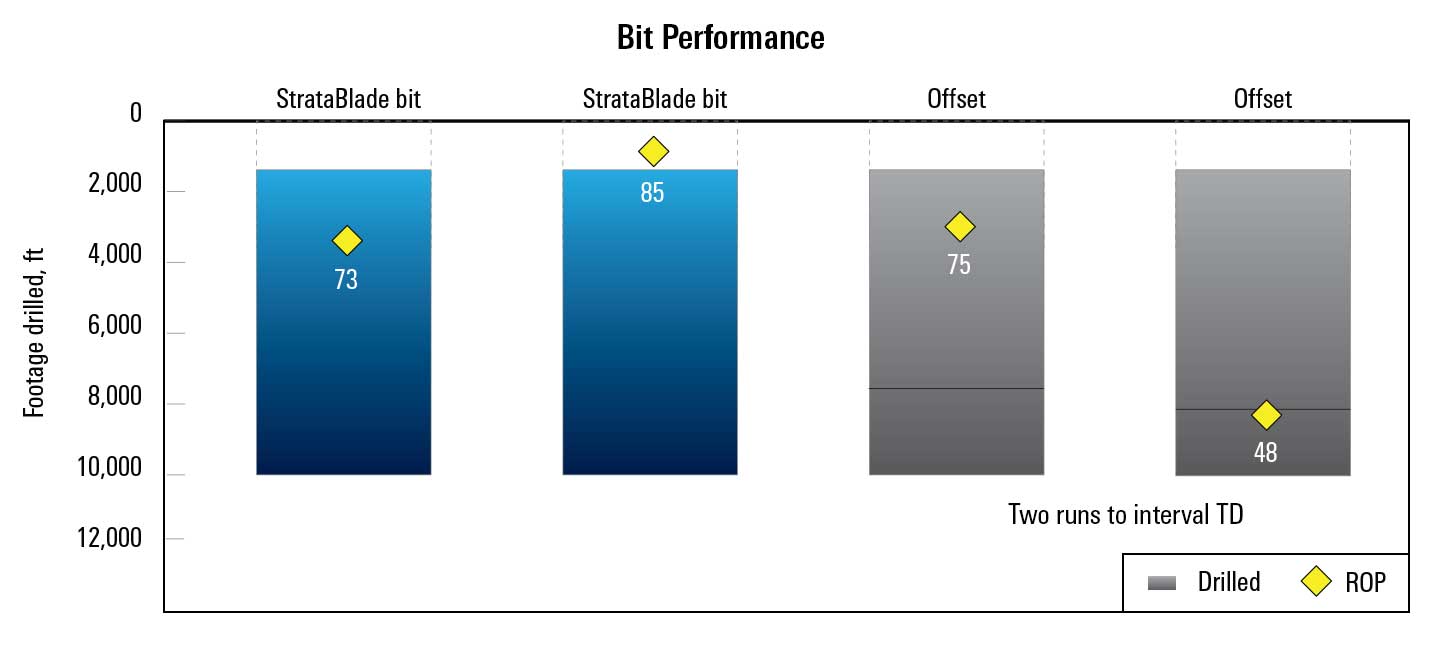Increase ROP by up to 35% in medium-strength formations as compared with flat PDC bits.
Concave Diamond Element Bits Drill Faster for Instantaneous ROP to Save Time and Costs
Published: 03/09/2021

Concave Diamond Element Bits Drill Faster for Instantaneous ROP to Save Time and Costs
Published: 03/09/2021

While drill bits account for a mere fraction of total well construction costs, it can be argued that no single piece of drilling equipment has more influence on drilling performance than drill bits do. Innovation of bits has evolved with the use of strategically shaped polycrystalline diamond compact (PDC) cutter technology—that is, where the cutter meets the rock.
StrataBlade concave diamond element bits by Smith Bits, a Schlumberger company, provide a new solution for customers to drill medium-strength and interbedded formations, while increasing ROP to reduce rig time and well construction costs. StrataBlade bits are the newest addition to the Smith Bits blade family of unique 3D cutting element bits. We spoke with Smith Bits Product Champion, Wiley Long, who told us more about this new offering on the market.
Tell us about the StrataBlade concave diamond element bit and how it fits into the Smith Bits blade family?
StrataBlade bits launched in October 2020 as an addition to our existing shaped cutting element technologies. They’re designed to enable our customers to improve ROP in a wide range of rock types, while withstanding impact damage often associated with drilling in interbedded formations. Specifically, they’re a fit-for-purpose solution to cut through those layered, medium-strength formations typically ranging from 5,000 to 20,000 psi. We’ve achieved this by creating a unique geometry with the Strata concave diamond elements, which feature a tapered ridge with a thicker diamond table to significantly resist cutter chipping as compared with traditional flat PDC cutters. And its distinctive concave feature that decreases the effective cutter back-rake angle enables the bit to penetrate deeper into the rock while applying the same WOB. Together, these characteristics increase cutting efficiency and sustain a higher instantaneous ROP.
When we started developing StrataBlade bits, we knew there was a gap in our portfolio offering a technology that meets the challenges of drilling in medium-strength and interbedded formations. Now, StrataBlade bits complement our 3D technology bit portfolio, which includes ridged diamond element bits and hyperbolic diamond element bits. Ridged diamond element bits are suitable for medium-to-hard formations and combine shearing with a plowing effect to reduce the cutting force needed to fail the rock. Alternately, hyperbolic diamond element bits suit soft and plastic formations and have a scooping effect for more efficient rock removal.
The first thing customers probably want to know is: How do StrataBlade bits reduce drilling costs?
Absolutely. With drill bits, in general, there are two primary ways in which they can lower drilling costs: first, by increasing ROP to reduce on-bottom drilling time, and secondly, by increasing durability to eliminate costly bit trips. StrataBlade bits have demonstrated the ability to achieve both objectives, saving rig time and costs by delivering higher ROP, and by withstanding impact damage while drilling highly interbedded applications to ensure shoe-to-shoe footage objectives are met.
For example, in one such deployment by a customer drilling in the Haynesville Basin of East Texas, the goal was to reduce bit runs and improve shoe-to-shoe performance in an intermediate section. The StrataBlade bit endured the abrasive and high-impact layers, enabling the operator to eliminate additional bit trips and improve ROP by an average of 28% compared with direct offsets.

Related case study: Operator Improves ROP in High-Impact, Abrasive Interbedded Layers, Haynesville Basin
How were the bits tested before going to market, and what were the results?
As with all of our products, lab and field testing is extensive, and for good reason. Before we run anything into a customer’s well, we want to be sure that we are confident enough to stand behind that product. In the beginning, we had an idea of where we wanted to run the bits based on comparing the needs of our customers with the drilling challenges that they face. The testing process started by conducting extensive lab testing on the individual cutter component to validate its cutting efficiency and durability. The design of StrataBlade bits were also used in simulations within the IDEAS integrated dynamic design and analysis platform, where we can see bit-to-rock interactions in virtual environments.
In early field tests, we wanted to further validate the desired outcome of improved cutting efficiency by observing that we could, in fact, increase ROP while applying either the same or lower WOB. And the results proved our findings with great success. For example, in field testing in the Appalachian Basin, an operator drilling an 8¾-in vertical section wanted to improve drillbit performance to increase ROP. The StrataBlade bit achieved 15% higher instantaneous ROP with the same WOB and rpm as compared with offset wells using benchmark bits.
Read full case study: Operator Cuts Deeper to Improve ROP in Medium-Strength Interbedded Layers, Marcellus Shale
In 2020, we conducted more than 100 field tests in the U.S. More than 95% of these runs delivered significant improvement in ROP when compared with their direct offsets. In all of these runs, the performance either met or exceeded our customers’ expectations in terms of footage objectives.
Where are the bits being deployed now?
Currently, StrataBlade bits are widely being used in the U.S. across all of the major shale play basins. We have also recently deployed bits in Canada, Russia, Thailand, Kuwait, and Brazil. These are all areas where we are confident that the technology will continue to replicate exceptional performance worldwide. And we look forward to continuously pushing the boundaries of what is possible in the drilling world.
Does the addition of StrataBlade bits complete the Smith Bits 3D technology bit portfolio? What’s next?
By no means do we consider our shaped cutter portfolio complete. Our engineering teams are constantly innovating and exploring how to incorporate new shapes into our cutters so our PDC bits can continue to elevate our customers’ drilling performance in any drilling application that they may face. In addition to creating new shapes, we see great opportunities to further enhance shaped cutter performance by continuing to put effort into the more traditional cutter development arenas such as material science and manufacturing processes. While cutter shape contributes greatly to cutting efficiency, materials science developments will ensure that goals for cutter durability are met in drilling applications that offer varying risks of abrasive wear, impact damage, or some combination of both.
A recent example of where we’ve seen these material science efforts succeed is with the ridged diamond element. With this cutting element, we retained the same external geometry of our proprietary ridged diamond element, but with slight modifications to the diamond feed and to the carbide interface, we were able to significantly improve its resistance to both abrasive wear and impact damage. We expect these types of efforts to be replicated across our portfolio of shaped cutting elements as we continue to gain more experience. Shaped PDC cutters have only been in the market for about seven years, whereas traditional flat cylindrical PDC cutters have been around for more than 40 years. So, we’re still early in the shaped-cutter evolution, and we believe there are still many good things yet to come.

